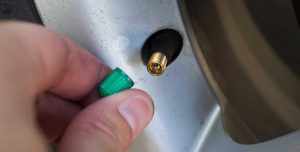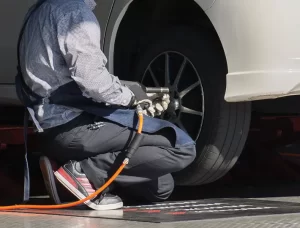To be accurate, nitrogen has always made up a large chunk of the air in your tyres. When you pull in at your local servo to pump your tyres up, you’re using a compressed version of the air that we breathe. This air is colloquially referred to as oxygen, but its breakdown is actually 78% nitrogen, 21% oxygen, with water vapour, CO2 and small concentrations of noble gases such as argon and neon making up the rest.
What we really mean when we’re talking about using nitrogen in tyres is using a mixture that’s made up of pure nitrogen (which is actually any mixture that contains at least 90% nitrogen). Why would we consider this?
Well, for some time now, high-performance vehicles (race cars, for instance) and aircraft have used nitrogen gas in their tyres. The reason for this is, in fact, to avoid moisture. Tyres filled with normal, compressed air contain a certain amount of H2O. At normal temperatures, such as a plane might experience on the runway, this water is present as droplets. Landing and braking, however, create extremely hot temperatures that convert water droplets to vapour, causing the tyre to expand and potentially explode. This is especially bad when we take into account the fact that oxygen is flammable.
Pure nitrogen isn’t flammable and contains no water, hence its use in the aviation industry and high-performance vehicles where high temperatures are a reality. Considering these sorts of temperatures aren’t normally experienced in everyday traffic, why would we consider nitrogen for our regular cars?
Why you should consider nitrogen in tyres for your car
The main benefit of nitrogen in tyres for the regular Joe Blow is its ability to maintain pressure. The more oxygen present in a mix, the faster it oxidises and leaks through the rubber, leading to under-inflated tyres. Nitrogen molecules are larger than oxygen molecules, making it harder for nitrogen to pass through the rubber. While the difference in size is only 2.6%, nitrogen-filled tyres leak three to four times slower than tyres filled with compressed air.
Why is this important?
We’ve said it many times before and we’re happy to say it again: under-inflated tyres are dangerous to your health and your hip-pocket. A tyre inflated to the incorrect pressure has reduced grip and impinges on your ability to control the car. Even a marginally deflated tyre has a marked reduction in capacity to displace water. When a tyre cannot properly displace water, it aqua planes and you have zero control over what happens next.
Also, under-inflated tyres wear faster due to increased friction, which means you’ll have to replace them sooner than would otherwise be necessary. We’ve seen tyres that have had their life span reduced by half due to under-inflation. And, yes, if more of your tyre’s surface is in contact with the road, the harder your car has to work to create movement, and a hard-working car has a hard-earned thirst. You can basically watch the petrol gauge plummet.
Now, nitrogen-filled tyres don’t maintain their pressure indefinitely; you do have to check them every once in a while. But it does mean they’ll stay properly inflated for longer, which is particularly good for people with super-busy lifestyles or those absent-minded individuals who only remember to check their tyres’ pressure once in a blue moon.
Get your nitro fix at Eastern Tyres
If you like the sound of only having to check your tyre pressures every three to four months instead of every four weeks, then pop into Eastern Tyre Centre and we’ll replace the regular, boring air in your tyres with pure nitrogen. Stable pressure, better grip, better performance, better fuel economy – it’s a lot to live up to, but nitrogen is up to the task.


